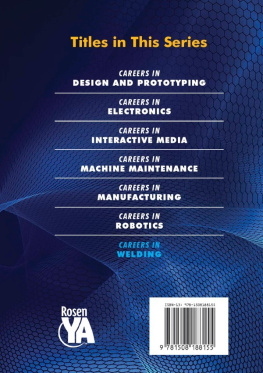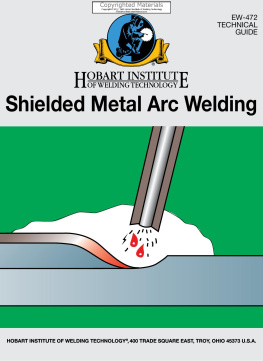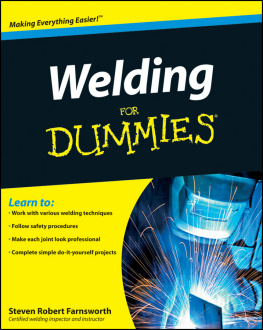
BEGINNING MIG WELDING AND METAL FABRICATION BASICS
STEPHEN BLAKE CHRISTENA

Contents
Introduction
W hile I was growing up in Flint, Michigan, my dad, brother, and I would make and fix all kinds of things. My dad instilled his philosophy in me at a young age: Why pay someone else to do something you can do yourself? We enjoyed fixing everything from cars to bicycles, dishwashers, and TVs. We re-roofed houses and rewired radios. We built wooden tool chests, skateboards, snowboards, and hockey sticks. We were always working on a wide variety of projects using everything under the sun and all kinds of cold connections like nuts and bolts, screws, nails, glue, epoxy, fiberglass, solder, pop rivetsyou name it; we used it. I grew up into a confident handyman and consummate tinkerer with an appreciation for three-dimensional construction.
By the time I started college I was no stranger to creating sculptures, furniture, art, and all sorts of other things using traditional woodworking and cold connection methods. But then in my first metal sculpture class, I cut into a piece of 11 ga mild steel with an oxy-acetylene gas torch and I was hooked. Metalwork and fabrication amazed me and became my passion. The way this cold, hard, and seemingly uncooperative material was so easily cut, formed, and manipulated still astounds me. As I learned how to weld, heat, bend, and cut various metals, I could not believe how these incredibly durable materials became as easy to work with as clay. Exploring the unlimited potential of metal work became the compass for the rest of my life.
I never stopped welding. After graduation, I moved to Chicago and set up my first shop on the south side, equipped with only a small 120 V Hobart MIG welder and grinder. Over the years, I moved my shop around a few times, expanded my gear, and worked in a wide range of fab shops, learning as much as I could along the way.
By the time I started my first fabrication company, I had worked for some of the top designers in the furniture industry and for world-class architects, and Id worked side by side with amazing metal artists, fabricators, and sculptors. Each of them influenced my perspective and expanded my knowledge of metal work, for which I am grateful.
Exploring the unlimited potential of metal work became the compass for the rest of my life.
Then a few years ago some motorcycle friends approached me and asked about learning to weld and chop frames for their race bikes. After a few basic lessons in welding, they were asking me to teach them how to make their own bikes lighter, how to weld and fabricate new parts, and how to build custom components. Before I knew it I was teaching community welding classes at my metal studio, Midwest Metalworks.
After a lesson recently, one of my students said to me, You can pretty much make anything, knowing how to weld. He had an amazed expression of bewilderment at the vast potential of this new medium that he had just learned. He had realized the fantastic new world of possibilities that I had discovered almost two decades before. Now you can too.
If you enjoy working with your hands, learning metalwork will give you a wealth of knowledge that will expand and challenge your ability to create. There are so many different techniques, styles, and methods to learn in welding, and in this book, I hope to introduce to you the enormous possibilities that come with each one.
The key place to start is learning the basics of Metal Inert Gas (MIG) welding, which well learn in the following pages. Youll learn the basic rules and principles of welding that can be applied to other processes such as Stick and Tungsten Inert Gas (TIG) welding. MIG is just the beginning.
It takes time and practice to become a good welder, but I hope through this text you will soon instinctively recognize a good weld that is laid properly. Just like an excellent musician knows when they are in tune or have played a bad note, an experienced welder understands their craft. The more arc time you log and the more projects you fabricate, the more the world of metalwork will open up to you.
Stephen Blake Christena, Chicago 2013
I
Welding 101
Welding: Start Here
I teach Metal Inert Gas (MIG) welding because it has become one of the most versatile methods of welding, its easy to learn, and its fun! It was originally developed for welding aluminum, but was quickly adapted to other metals such as mild and stainless steel. It has become extremely popular amongst all industries from hobbies to shipyard for its ease of use, versatility, and speed.
MIG welding is the focus of this book, but before we dive into it, I wanted to give you an overview of electrode arc welding and some insight into the readily available welding processes out there.
How Welding Works
There are several different methods of welding. Today, the most common welding process is electrode arc welding. There are three types, or systems, of arc welding in this family: stick, MIG, and TIG. All three types of arc welding use the same three components. The first and most obvious is electricity, which creates the arc. Each type also uses a filler material, and the third component is flux. The differences between stick, MIG, and TIG arise in how the three of these elements are used to create a bead (a bead being the weld that is created); each type of welding has a different method of execution.
Before we talk about the differences in welders and the methods of execution, we should go over how arc welding works in general. The best way to explain this process is to clearly define the elements of welding and what they do.
The Arc
Static shock, lighting, and spark plugs firing in a vehicles engine are all examples of an electric arc. Not many people are aware of this, but an electric arc is actually a state of matter called plasma, which is similar to gas. The arc is created by an electrical current moving through the work piece from the welding machines ground clamp to the electrode. The electrode is an electrical conductor used to complete the circuit, which allows the welding machine to create an arc. The arc is created by a breakdown of a gas that discharges plasma. Certain gases such as argon, carbon dioxide, and helium have a higher conductivity and ionization that assists in creating and maintaining the arc, making them candidates for a shielding gas.

Make sure to wear proper safety gear. Skin left exposed to the arc light can get a pretty bad sun burn. I dont recommend it.
In the stick and MIG welding processes, the electrode is also the filler metal. When the filler material comes into contact with the grounded piece of base metal, it completes a circuit that creates the electric arc. The arc forms at the very end of the filler material, which melts into the weld zone, creating the joint. In the TIG welding processes, the electrode is a rod of tungsten.












